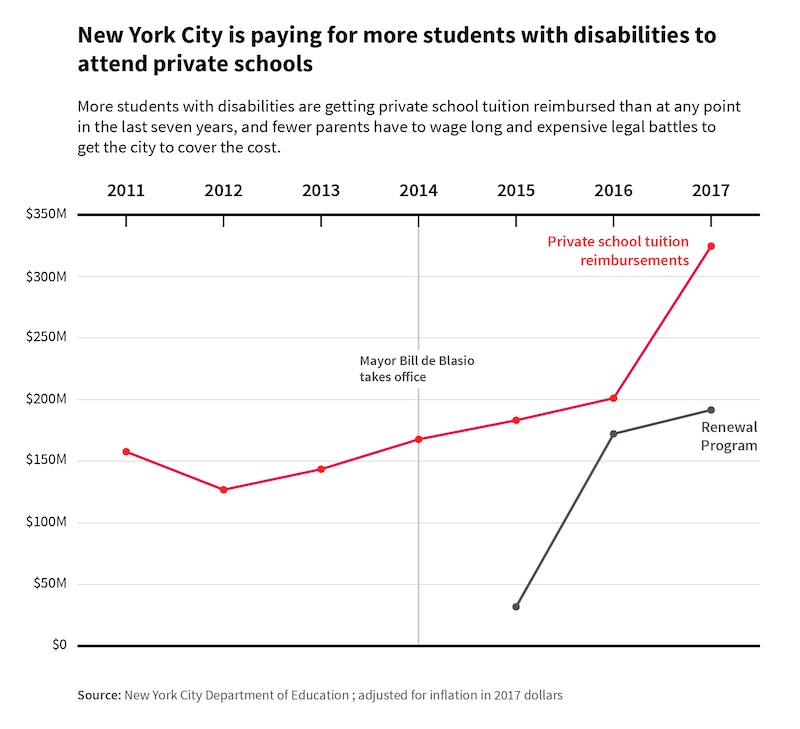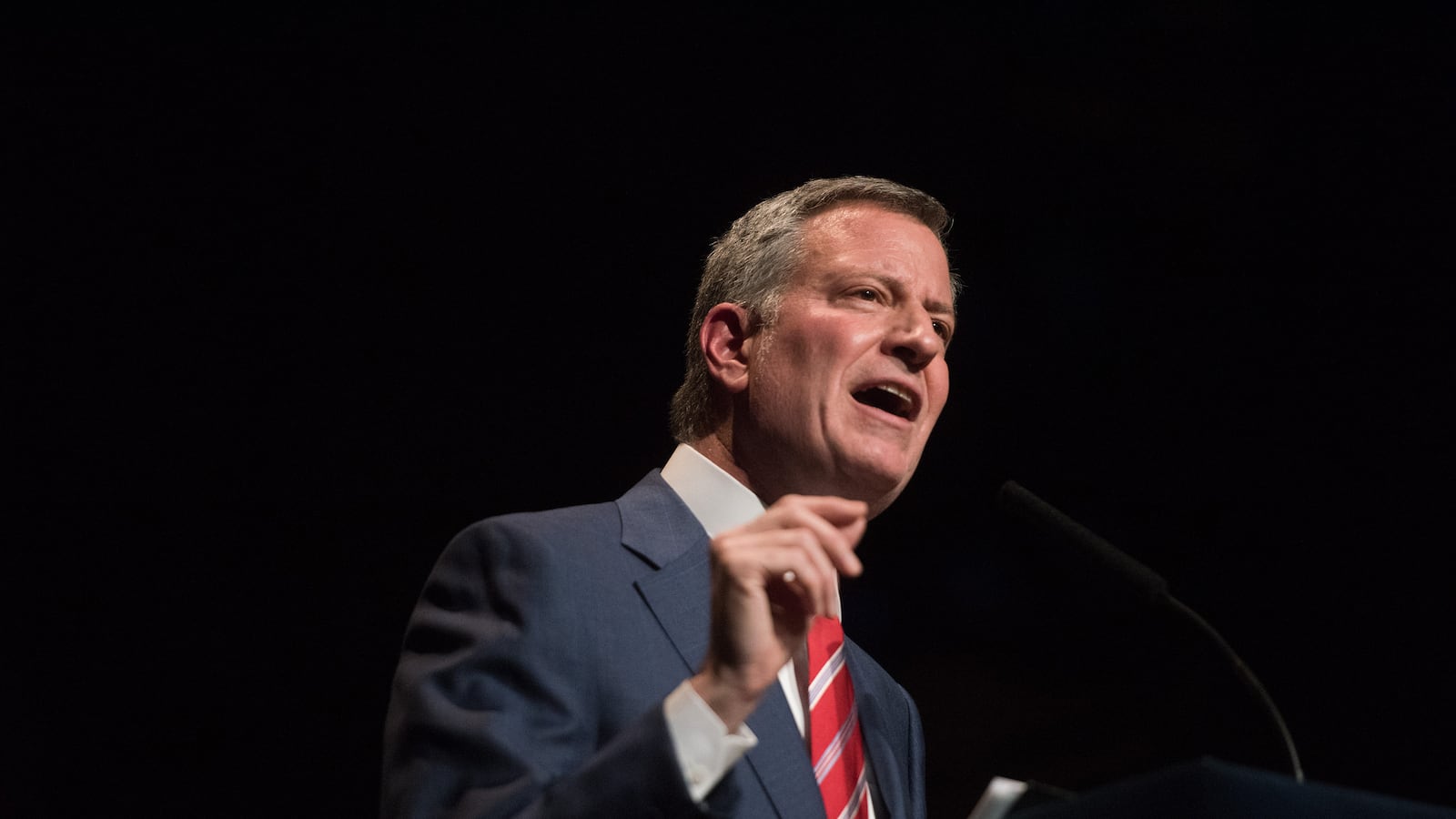Shortly after Mayor Bill de Blasio took office in 2014, he made it easier for students with disabilities to attend private schools with the city picking up the tab.
That policy change is quietly having an enormous impact: The cost of sending students with disabilities to private schools has doubled since de Blasio was sworn in and has reached $325 million per year, dwarfing the price tag of some of the mayor’s highest-profile education initiatives.
The expense eclipses the mayor’s Renewal program to turn around struggling schools ($192 million per year); a recent increase in the funding formula that governs city school budgets ($125 million); and even the often-debated Absent Teacher Reserve for educators without permanent placements ($136 million in 2018).
The sharp increase is notable because it suggests the city is increasingly acknowledging that it can’t provide an adequate education to students with disabilities within traditional public schools. And the trend is at odds with schools Chancellor Richard Carranza’s desire to send fewer students with disabilities to schools outside the system.
“It’s telling that the city doesn’t have the programming needed to educate a lot of kids,” said Lori Podvesker, a policy manager at INCLUDEnyc, a support agency for young people with disabilities.
Officials said 4,431 students with disabilities attended private schools paid for by the education department in fiscal year 2017, according to the most recent data obtained by Chalkbeat, a third more than in 2014. Overall, there are roughly 225,000 students with disabilities in city schools.

De Blasio’s decision to make it easier for families to receive private school tuition reimbursement was a direct reversal of his predecessor’s approach. Though federal law allows families to petition for private school funding through a special hearing when the city fails to provide an “appropriate” public education, Mayor Michael Bloomberg hired extra lawyers to fight parents’ private school reimbursement requests as a way of avoiding unnecessary placements and saving money that could be reinvested in the system as a whole.
In response to pressure from lawmakers, de Blasio rolled that policy back. At a press conference announcing the shift in June 2014, he said the city needed to adopt a “family-friendly, respectful approach that didn’t matter how good your lawyers were, or how much money you had to spend on lawyers, but actually tried to address the family’s needs.”
Under the new policy, the mayor promised the city would not fight cases that it had settled in a previous year or that parents had won in a legal fight — as long as the child’s recommended placement and learning plan stayed the same. Since 2014, the number of reimbursement cases that the city settled without going to a hearing has jumped 54 percent.
The city also said it would “expedite” tuition payments for all families, even those who never previously sought reimbursements, as another sign the de Blasio administration would not contest such outlays.
But Carranza has said it’s a bad idea to send more students with disabilities to private schools, a position that is out of sync with the policy changes de Blasio has championed.
At a town hall meeting in September, Carranza acknowledged that the city doesn’t offer the full range of programs that are listed on student’s learning plans but argued it would be more cost effective for the city to create programs on its own. “It eliminates the need for people to find services outside of our system,” he said at the meeting. “That’s where we want to go.” (Education department officials did not respond to a question about whether Carranza is considering any changes to the tuition reimbursement policy.)
Among special education advocates, there is little consensus on whether paying for students with disabilities to attend private schools is good for the system or is the best investment of limited education funding.
“The premise behind the policy is a good one,” said Rebecca Shore, the litigation director for Advocates for Children, which represents low-income families in reimbursement cases. Families have generally had to devote less energy to fighting cases year after year, she said. Without the policy, “more students with disabilities would not be receiving an appropriate education.”
Other advocates argue that relying on private schools to provide an adequate education doesn’t address the root problem of the city not being able to serve thousands of students in public school classrooms, and also raises serious concerns about which types of students benefit from attending private schools. Because the reimbursement process is so complicated and legalistic, parents often hire experts to guide them and secure tuition payments, which means more affluent families who have access to time, money, and lawyers are likely to benefit.
“It’s not a systemic solution,” said Meghan Whittaker, policy director for the National Center for Learning Disabilities, a nonprofit advocacy organization. “It takes a parent who really knows the options available to them and knows their rights and can navigate the process.”
But hard data is difficult to come by. Over two years, education department officials have repeatedly refused to disclose the demographics of students who get private school tuition reimbursements. In 2016, the education department denied a request for those statistics filed under the state’s open records law.
The increase in tuition reimbursements has not been spread out evenly in recent years. In the 2017 fiscal year, tuition reimbursements jumped 61 percent compared with the previous year to nearly $325 million (the number of students receiving reimbursements only increased 17 percent over the same period). Education officials said the large increase was partly due to $40 million in payments from previous years that were not processed until 2017.
A former education department official, who requested anonymity to speak candidly, expressed surprise that tuition reimbursements have increased so significantly and argued the money could be more effectively used.
“It’s hard to make the case that doubling what was already a very high number in private school tuition reimbursements is the right answer to the problem,” the official said. “If you invested money in improving the special ed system, it might be better spent.”
The city has made some progress expanding programming for students with disabilities, including bilingual offerings and programs for students with autism, according to an education department spokesperson. Only about 2 percent of all students with disabilities have private school tuition reimbursed, the spokesperson added.
“We’re committed to providing students with disabilities with the services they need to succeed inside public school classrooms,” wrote Danielle Filson, a department spokeswoman. “We’ll continue to support families with valid claims throughout the [reimbursement] process so that every student can receive a high-quality education suited to their needs.”
Dolores Swirin-Yao, whose son has received private school reimbursements for seven years, said the city has still not always paid families on time, even under the new policy, a concern that some advocates have also raised. (City officials said they are hiring additional staff to handle these cases.)
She decided to place her son, Jeremy, into a private school after he continued to struggle identifying letters and numbers in the second grade. “I think they gave up on his ever being able to read,” she said of his public Brooklyn elementary school.
Now a seventh-grader, Jeremy attends the Aaron School, which costs $69,125 per year, according to its website. Swirin-Yao said the school has been better-equipped to handle his learning delays, dyslexia, and attention issues. The difference is “night and day,” she said, adding that Jeremy is close to reading at grade level.
But she still feels ambivalent about sending him to private school, even if she believes it’s the best option for her son.
“We would have definitely wanted to have him in public school,” she said. “If a for-profit company that owns Aaron School can run a beautiful little school like this, why can’t the city do it?”

